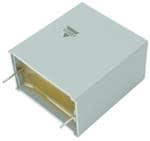Why do inductors and capacitors differ?
The inductor vs capacitor is a passive electronic device used in electrical circuits to manipulate and store energy. As current flows through an induction device, a passive electrical component, the potential is stored as a field of magnets. It consists of a material core encircled by a wire coil. The qualities of the core material and the number of coil turns affect how much inductance is produced. An electrical capacitor is a neutral part that stores the energy of an electric field when a voltage is passed across it. A dielectric (insulating material) separates the two conducting plates that make up the device. As soon as a voltage is applied, electric charge accumulates on the plates, creating a field of electricity between them. They display distinguishing characteristics and actions, including:
- It stands for the inductor’s capacity to hold energy as an attractive field. The capacity to store energy increases with the inductance. Reactance, which inductors introduce into AC circuits, prevents variations in the current flow. It becomes more frequent.
- It stands for the capacitor’s capacity to hold electrical charge. For a given voltage, a capacitance of greater magnitude can store more charge. In AC circuits, capacitors add reactance, which prevents voltage fluctuations. It gets less frequent with time.
Understanding the differences between inductors and capacitors and how they influence electronic circuit design:
Basic passive electrical components like inductor vs capacitor are essential for electronic circuits. Although they are used to control and store electrical energy, they operate very differently from one another. Let’s examine how inductors and capacitors affect electronic circuits and their distinctions.
- Storage of energy and purpose:
The capacitor is a device that uses a field of electricity to store electric power. It comprises two directing plates isolated by a dielectric, which is an insulator. Positive charges build on one plate, and negative charges accumulate on the other when a voltage is applied across the plates, forming an electromagnetic field between them. A device known as an inductor stores electrical power as an attractive field. Typically, it is prepared by coiling a wire around a material core. As electricity flows through the coil, a field of magnetic attraction surrounds it.
- Voltage and current response:
A capacitor’s voltage cannot fluctuate instantly. There is a delay in reaction when the voltage across a capacitor changes because the plate charge needs time to redistribute. It is standard practice to utilize capacitors to filter, amplify, and block DC signals while letting AC signals flow through. An inductor resists variations in current flow. When an inductor’s current varies, its voltage across its terminals causes a “back EMF” to resist the change. Inductors are frequently utilized to filter, store energy, and produce delays in AC circuits.
- Impedance:
As the frequency rises, a capacitor’s impedance falls. For AC signals at high frequencies, it functions as a short circuit, while for DC signals (steady-state), it functions as an open circuit. As the frequency rises, the inductor’s impedance rises as well. It functions as an open circuit for high-frequency AC signals, while for steady-state DC signals; it functions as a short circuit.
- Response to Frequency:
High-pass and low-pass filters frequently employ capacitors. They enable low-frequency signals in a low-pass filter and high-frequency signs in a high-pass filter to pass through. Both filters employ inductors. In a low-pass filter, they let low-frequency signals through; in a high-pass filter, they let high-frequency signals through.
- Applications:
Capacitor applications include energy storage, coupling and decoupling in power supply, reducing voltage fluctuations, and timing circuits. Transformers, inductance coils, noise-canceling chokes, and devices like inductance-driven power supplies all use inductors, also used as energy storage. Components called inductors can convert electrical energy into magnetic energy. They may be found in various products, including radios, power supplies, and medical gear. It produces oscillating fields or currents; circuits can also utilize inductors. Aluminum, iron, and copper are some materials used to make inductors.

Tips for using inductors vs Capacitors:
- Magnetic fields can flow through certain types of electrical components called inductors. When an inductor is used, energy continually passes through it, creating a little alternating current. Circuits employ inductors to maintain a steady flow of electricity and prevent interference. Unlike a battery, a capacitor lacks a switch or button. It is a passive gadget that uses no energy. It doesn’t need a switch or a button and may be attached to any circuit. However, if the voltage provided to the circuit is lower than the voltage kept in the capacitor, it cannot function. A capacitor should always have dry and clean exposed ends.
- Maintaining the insulating substance between a capacitor’s plates is crucial. The capacitor will only function correctly if it is fixed or maintained clean. Only a direct current source with the same polarity will function with a capacitor. A capacitor won’t function if it is attached to a circuit that needs current with a positive polarity. During solar energy’s peak hours, storing energy in a capacitor is preferable. Since most of us consume power at night, it is suggested that energy be stored in a capacitor during the day for EASYIEE.
Conclusion:
If you’re anything like me, capacitors and inductors have always piqued your interest, but you may need to fully comprehend what they are and how they operate. By the time we’re done, you’ll understand much better how crucial these little components are and why it’s so crucial to maintain them in good working order. In electrical circuits, two fundamental elements—inductor vs capacitor play a significant role in the operation and efficiency of numerous devices. These passive electronic parts are frequently employed to manipulate and store electrical energy, but it also have unique traits and behaviors that make them stand out. EASYIEE elements are widely utilized in various applications, including power supplies, filters, amplifiers, and oscillators.





 2023-08-08
2023-08-08 


